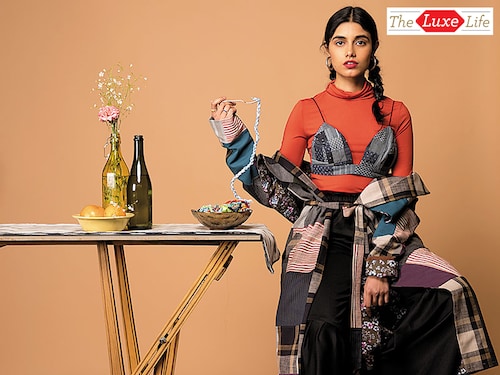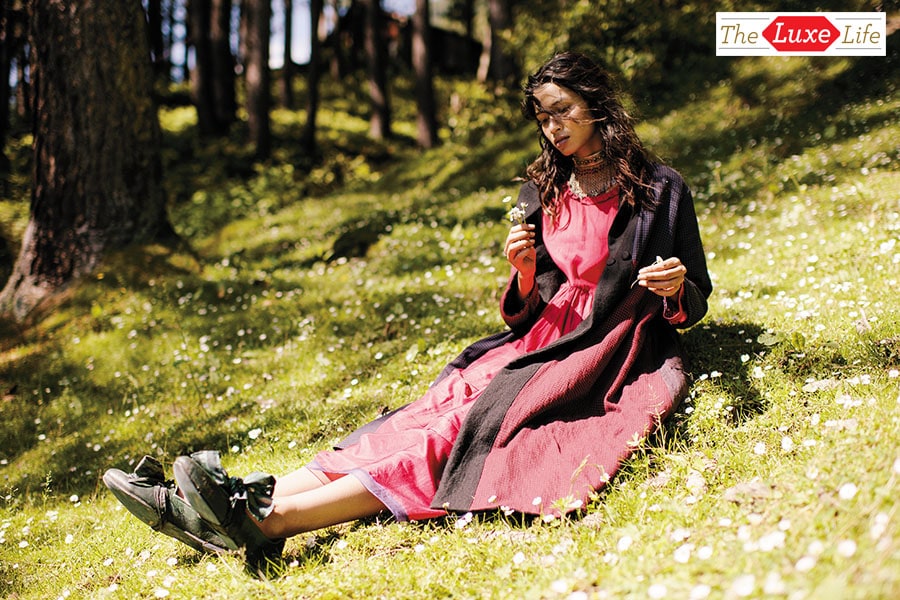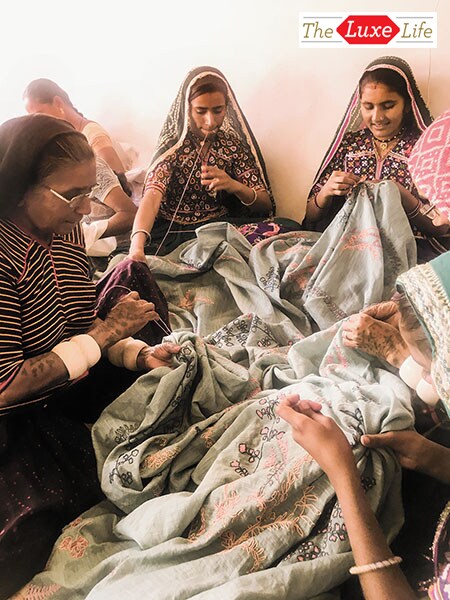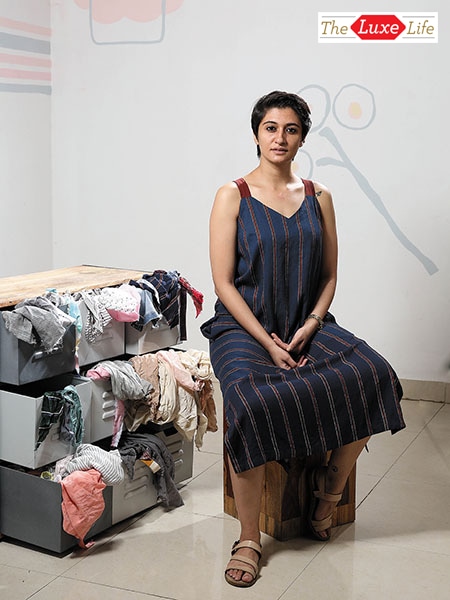Why is sustainable fashion so expensive?
The virtues of sustainable clothing are many, but a lot of them fall in a price bracket well beyond the reach of most


 Sustainable clothing from the Autumn/Winter 2019 collection by Rina Singh, founder, Eka
Sustainable clothing from the Autumn/Winter 2019 collection by Rina Singh, founder, Eka
“The term ‘sustainable fashion’ is an oxymoron,” says Rina Singh, founder of Eká. “Because if you are going to create something fashionable, it cannot be sustainable.”
The fashion industry is plagued with inherent issues that make it unsustainable. From the use of chemical dyes and synthetic fibres that pollute the environment, and the enormous amounts of waste it generates in the form of fabric scraps, to the employment of low-wage workers in cramped and unsafe conditions in sweatshops around developing countries, there are several factors that contribute to this unsustainability.
Adding to this is the recent concept of ‘fast fashion,’ where inexpensive clothing is rapidly produced by manufacturers to meet latest trends, and consumers buy and discard them within short periods of time, sometimes after wearing them only once. This not only exerts enormous pressure on resources and production processes, but it also generates vast amounts of clothing as waste that ends up in landfills.
Hence, the concept of sustainable clothing—as opposed to sustainable fashion—is one that not only addresses the issues of sourcing responsibly and adopting production techniques that are sustainable for all stakeholders, but it also stands for raising awareness among consumers about buying less and thoughtfully.
What the adoption of these practices therefore does is push up prices, thus nudging sustainable clothing into the realm of luxury.
*****
When we started out in 2014, it was not about starting a label but a conversation around the issues of wastage in the industry,” says Kriti Tula, designer and founder of Doodlage, a Delhi-based label that works with fabrics that are generated as waste by other garment manufacturers. “I had thought about starting Doodlage before I went to London for my masters in 2012. While there, I got a chance to understand the global conversation around sustainability, which made me more determined to start this conversation in India.”

An outfit from Doodlage by Kriti Tula, which is positioned as an aspirational, but affordable brand[br]Doodlage estimates that post-cutting waste, stitching waste, defective fabrics, misprints and end-of-line fabrics in mass production set-ups account for 16 to 20 percent of the total fabric consumption in a large-scale garment production unit in India this could be about 45,000 metres of fabric daily. “When we started, there was no supply chain for fabrics like this,” adds Tula. “So we had to set up everything from scratch.”
Working with similar products—upcycled and recycled fabrics and yarns—is Sohaya Misra, who started the Chola brand of attires as an experiment in 2015. “We have teamed up with Anandi Enterprises in Tamil Nadu, from where we get fabrics that are made of recycled cotton fibres,” says Misra, whose collection was showcased as part of the Sustainable Fashion Day at the 2017 Lakmé Fashion Week. “Our designs are inspired by the fabrics themselves, so we don’t manipulate them in any way by additional dyeing or embroidery. We have free cuts that minimise wastage.”
With the increasing realisation of the unsustainability of cotton as a natural source of fibre for fabrics—according to the World Wide Fund for Nature, it takes more than 20,000 litres of water to produce just 1 kg of cotton—designers are experimenting with other sources of natural fibres. “For the latest collection of AW19, we have a growing selection of sustainable fabrics made from bamboo, tencel, cupro and organic cotton,” say Rahul Rai and Simral Lal, co-founders of Nicobar, a design and lifestyle studio. Tencel is a fabric made from the wood pulp of trees that are grown and replaced on special farms, and uses recyclable, eco-friendly solvents, while cupro is a regenerated cellulose fibre, made from the extra fibres of the cotton seed that would otherwise be thrown away. Anita Dongre’s brand Grassroots works with the Self Employed Women’s Association in various regions[br]Being sustainable is not just about being careful about the environmental impact of the sourcing process, but also its social impact, such as creating long-term livelihoods for the people who are involved in the manufacturing process. “We work with different craft clusters across the country and through intelligent design intervention, amalgamate age-old crafts with mainstream contemporary fashion, thereby creating a sustainable ecosystem for the craft and its maker,” says Anita Dongre, whose apparel brand Grassroots works with members of the Self Employed Women’s Association (SEWA) across various states, including Gujarat “to make beautiful clothes while creating beautiful tomorrows for our people, planet and crafts. This not only empowers the artisans and helps keep the craft alive, but also enables in elevating their quality of living.”
Anita Dongre’s brand Grassroots works with the Self Employed Women’s Association in various regions[br]Being sustainable is not just about being careful about the environmental impact of the sourcing process, but also its social impact, such as creating long-term livelihoods for the people who are involved in the manufacturing process. “We work with different craft clusters across the country and through intelligent design intervention, amalgamate age-old crafts with mainstream contemporary fashion, thereby creating a sustainable ecosystem for the craft and its maker,” says Anita Dongre, whose apparel brand Grassroots works with members of the Self Employed Women’s Association (SEWA) across various states, including Gujarat “to make beautiful clothes while creating beautiful tomorrows for our people, planet and crafts. This not only empowers the artisans and helps keep the craft alive, but also enables in elevating their quality of living.”
Working with the same set of craftsmen is one way to ensure that they are able to carry on a tradition that they have inherited from generations. “Our work has always been focussed around cluster development, as we felt that we could add value to the process by combining the skills of these craftsmen with our designs, and make products that are suitable for a global market,” says Ruchi Tripathi, co-founder of Indigene, a conscious clothing label. “Sustainability is a complex subject, and is not just about hand-woven fabrics,” adds co-founder Jaya Bhatt. “The entire supply chain matters.” Ruchi Tripathi and Jaya Bhatt (right), co-founders of Indigene, Believe that sustainability goes beyond just hand-woven fabrics
Ruchi Tripathi and Jaya Bhatt (right), co-founders of Indigene, Believe that sustainability goes beyond just hand-woven fabrics
Image: Madhu Kapparath[br]Indigene, which was started in 2011, has been working with the same set of craftsmen for instance, they source ajrakh fabrics from Kutch, khadi from West Bengal and ikat from Telangana. “We also work with a group of 20 to 25 women from Sarita Vihar, a slum area in Delhi, who were initially semi-skilled in hand-embroidery,” says Bhatt. “Over the years we have seen their skill levels improve, along with their livelihoods.”
Design label Ka-Sha, started by Karishma Shahani Khan of Pune, works with cooperatives of weavers in different parts of the country: Silk from Bhagalpur, malkha from Hyderabad, khadi from Kerala, cottons from Gujarat and Jaipur, and handwoven fabrics from Chanderi and Maheshwar. Eighty to 85 percent of the material comes from handlooms. “We don’t like to use the word ‘sustainable’ since it is overused, and much abused,” adds Shahani. “We are making clothes that last a long time we work with upcycled and recycled fabrics. This is the kind of textiles we need to wear.”
Singh, of Eká, has been working with the same craftsmen for a decade. “Sustainability means sustaining a craft,” she says. “And I have to keep a craft relevant through the designs that I make.” Karishma Shahani Khan, creative director, Ka-Sha
Karishma Shahani Khan, creative director, Ka-Sha
Image: Jignesh Mistry for Forbes India[br]Keeping designs relevant season after season is at the core of Shahani’s creations for Ka-Sha. “The idea is that consumers should be able to wear these clothes for many seasons, without worrying about the current trends,” says Shahani, who works out of her studio in Pune. “That is why we have designs with a lot of layers that clients can wear and style in different ways.”
Singh says fashionable women may not identify with the clothes that she designs, since they are not mass produced with the intent to bring down costs. “Eká is an elegant brand and has created a niche for itself. It will not make you fit into fashion circles, and make you stand out instead,” she says. “They are for women who are settled in their choices and are happy to wear them season after season.”
“Nicobar is a brand that celebrates a modern Indian tropical aesthetic and it is through our products that we want to sensitise our guests to a more thoughtful way of living,” say Rai and Lal. “For example, our clothes are style-led and not trends-led which means that they will never go out of fashion.”
Where design aesthetics are concerned, sustainable clothing brands are often associated with certain signature characteristics, such as anti-fit cuts, minimal embellishments, and muted colours. “I think these are a natural outcome of the kind of fabrics and techniques we use,” explains Tula. “For instance, natural dyes are usually not shiny and glossy as fast colours, nor do they have as wide a colour range the texture of natural fabrics is very typical and unlike the fabrics made with polyester and other synthetic fibres.” Chola, for instance, is defined by its clean lines and simplicity. “I am heavily inspired by Japanese designs, and like my clothes to be structural in nature,” says Misra.“When I design something, I don’t think about whether it is for a man or women. Age, sex and size are no bar for my designs.” In keeping with this mantra, Misra’s collection showcased at the 2018 Lakme Fashion Week was gender-neutral, with women and men dressed in drag modelling her clothes.  Kriti Tula, designer and founder, Doodlage
Kriti Tula, designer and founder, Doodlage
Image: Madhu Kapparath[br]Even though designers are making a move away from mass-produced, environmentally and socially unsustainable sourcing and manufacturing practices, winning over consumers remains a tough nut to crack. “They will come, take a look at the designs, and say, ‘Lekin yeh toh cotton hai [but this is cotton]’, immediately implying that it does not deserve this price,” says Shahani. “Then it is up to us to make them realise, that yes, this is indeed cotton, and highlight the workmanship and skills that have gone behind creating it.”
Luxury clothing brings with it the perception of expensive looking materials, trendy cuts and colours and, often, bling. Sustainably made clothes would almost never tick any of these boxes. “Marketing sustainable labels is a big challenge if the products don’t look luxe enough,” says Bhatt of Indigene. “People are accustomed to look for occasion wear, whereas we make garments that can be worn from the day till evening.” There is also the challenge of not constantly supplying fresh, new designs to stores from where they retail, since the time taken to create a new line of garments—from the point of conception to the finished product—could take between six and eight months.
“The primary challenge has been changing people’s perspective of fashion,” says Dongre. “It involves helping a shopper, who is trained to expect seasonality and speed in fashion, to appreciate the beauty and value in slow fashion.”
Singh explains that if a certain craft—whether it is of weaving or dyeing or embroidery—takes a month and a half to complete, then that is time it will have to be given. Craftsmen who are employed in the process will need to be paid for the entire duration of the process.“By trying to speed up the process, you will actually be killing it,” she says.
Dongre adds that one of her greatest learnings, through Grassroots, has been that handcrafts take time and won’t submit to a schedule. Every piece of fabric that is woven, block-printed or embroidered is done by artisans who give it the time and attention it deserves.
But must sustainable clothing be available at luxury price points? “Every product is created keeping in mind a market that it is catering to,” says Tula. “If brands are positioning themselves at an inaccessible price point for a mass consumer, they are making a choice to serve a luxury market. And the details of the product or brand value created will justify these costs.Doodlage is positioned as an aspirational, but affordable brand. She adds that it is up to an individual on how they perceive luxury, and if someone is purchasing more and more, it may not be possible for them to make the switch easily to buying less, but buying better.
Dongre believes that the idea of sustainable clothing being expensive is a myth. “As opposed to fast fashion, sustainability encourages people to buy less so that they discard less. This has led to consumers re-examining their tendency to over-buy and under-wear apparel—consequently leading to a higher demand for sustainable apparel,” she says. Grassroots, however, is positioned as a sustainable luxury brand that combines traditional Indian crafts with contemporary styles.
Tripathi of Indigene says people in India are accustomed to handmade clothing, and are therefore less appreciative of them. “Sustainable clothing is a luxury because it includes all these hand-made products and detailing. However, we don’t want to make it completely out of reach and would want to cater to a larger market,” she says.
As India’s apparel market balloons—according to data from McKinsey’s FashionScope, it will be worth $59.3 billion in 2022, making it the world’s sixth largest, comparable to the UK’s ($65 billion) and Germany’s ($63.1 billion)—more than 300 international fashion brands are expected to open stores in India by 2021. As Indian consumers warm up to the availability of both—expensive high-street and designer pret labels as well as inexpensive mass-produced labels—thanks to a multitude of ecommerce platforms, wooing them with the virtues of slow and sustainable fashion may take its time.
It is little surprise then that most of these brands find more takers in foreign markets, especially the US, rather than in India. Because, as it turns out, affording sustainable clothing in India could well be a luxury.
First Published: Oct 22, 2019, 11:59
Subscribe Now